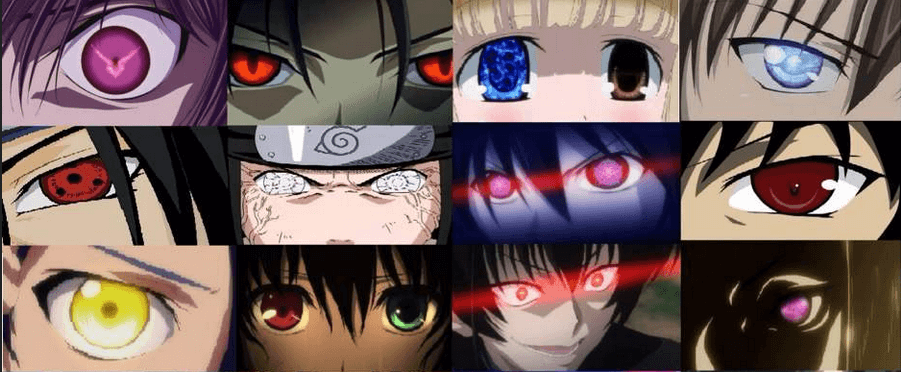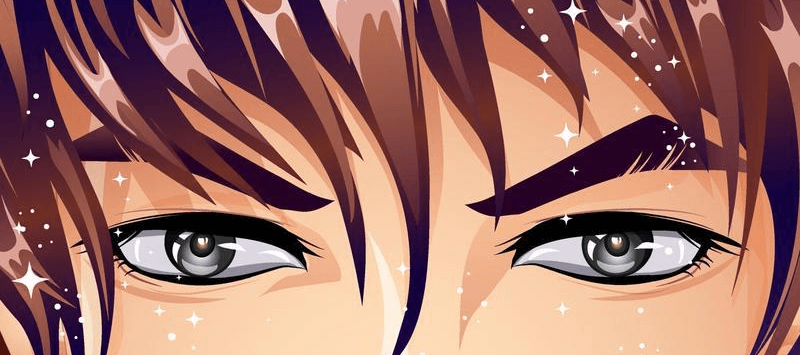📑Table of Contents:
Anime’s distinctive Japanese animation style has captivated audiences worldwide with its unique artistry and storytelling. One of the most striking features of anime characters is their eyes—large, expressive, and often full of emotion. These iconic designs are more than just a visual choice; they are crucial to how anime characters communicate and connect with viewers.
In this blog post, we’ll explore anime eyes, their symbolism, the various evolved styles, and how they play a vital role in storytelling.

The Origins of Anime Eyes: A Brief History
The distinctive look of anime eyes can be traced back to the early days of Japanese animation, influenced by Western and Eastern artistic traditions.
- Influence of Western Animation: The large, expressive eyes seen in anime were heavily influenced by early Western cartoons, particularly the works of Walt Disney. Osamu Tezuka, often called the “God of Manga,” was inspired by Disney characters like Bambi and Betty Boop. He adopted the oversized eyes to give his characters a greater range of emotional expression, which became a hallmark of his work.
- Evolution in Japanese Art: While Western influence played a role, anime eyes also drew from traditional Japanese art forms, such as ukiyo-e, where artists often used exaggerated features to convey emotion. This blend of styles created something uniquely Japanese—anime eyes that are visually appealing and deeply symbolic.
The Symbolism of Anime Eyes: Windows to the Soul
In anime, eyes are more than just a physical feature; they are a window into a character’s soul. A character’s eyes’ size, shape, and color can convey many emotions and personality traits, often without words.
1. Size and Shape: Conveying Innocence, Power, and Mystery
The size and shape of anime eyes are carefully chosen to reflect a character’s inner qualities. These visual cues help viewers instantly understand a character’s personality.
- Large Eyes for Innocence: Characters with large, round eyes are often portrayed as innocent, youthful, and pure. This design choice makes them appear more open and vulnerable, inviting empathy from the audience. Examples include characters like Usagi Tsukino from Sailor Moon and Hinata Hyuga from Naruto.
- Narrowed Eyes for Strength: Characters with narrow or slanted eyes are typically depicted as strong, confident, and sometimes mysterious. These eyes can suggest a more guarded or complex personality, as seen in characters like Levi Ackerman from Attack on Titan and Sesshomaru from Inuyasha.
- Sharp or Angular Eyes for Power: Angular eyes, often with sharp corners, convey power and determination. These characters are usually leaders or warriors, exuding an aura of strength. Examples include Vegeta from Dragon Ball Z and Erza Scarlet from Fairy Tail.
2. Eye Color: A Palette of Emotions and Symbolism
In anime, eye color is a stylistic choice and a powerful tool for conveying deeper meanings and emotions. A character’s eyes often reflect their personality, powers, or destiny.
- Blue Eyes for Purity and Calm: Blue eyes in anime often symbolize purity, calmness, or a connection to sky or water. Blue-eyed characters like Sakura Kinomoto or Edward Elric are often kind-hearted and trustworthy.
- Red Eyes for Power and Mystery: Red eyes often signify characters with great power, mystery, or a dangerous edge. These characters might have supernatural abilities or a dark past, adding layers to their persona. Examples include Kurapika from Hunter x Hunter and Gaara from Naruto.
- Golden Eyes for Uniqueness: Golden or yellow eyes often indicate uniqueness or a special destiny. Characters with this eye color might possess rare abilities or play a pivotal role in the story. Notable examples include Natsu Dragneel from Fairy Tail and Saber from Fate/Stay Night.
The Evolution of Anime Eyes: Trends and Changes Over Time

Anime eyes have evolved significantly over the decades, reflecting changes in artistic trends, cultural shifts, and advancements in animation technology.
1. The Classic Era: Simplicity and Bold Expressions
In the early days of anime, eyes were large, bold, and simple. This style, popularized by Osamu Tezuka, was easy to animate and allowed characters to express a wide range of emotions clearly.
- Tezuka’s Influence: Tezuka’s characters, like Astro Boy and Black Jack, featured large, round eyes with simple, bold lines. This style was expressive and easy to replicate, making it a staple of early anime.
- 1970s and 1980s Trends: In the 1970s and 1980s, anime eyes remained large and expressive but became more detailed. Shows like Candy Candy and Urusei Yatsura exemplify this trend, with eyes that convey basic emotions and subtle nuances.
2. The Modern Era: Realism and Complexity
As anime progressed into the 1990s and beyond, the design of anime eyes became more varied and complex. Artists began experimenting with different shapes, sizes, and levels of detail, reflecting the diverse range of characters and stories in modern anime.
- Detail and Realism: In modern anime, eyes are often highly detailed, with multiple layers of shading, highlights, and reflections. This adds depth to the character’s expressions, making them feel more lifelike and emotionally complex. Examples can be seen in series like Attack on Titan and Demon Slayer.
- Variation Across Genres: Different genres of anime now feature distinct eye styles. For instance, in shoujo anime (targeted at a young female audience), eyes are often exaggerated and sparkling, symbolizing innocence and romance. In contrast, shonen anime (targeted at a young male audience) might feature sharper, more intense eyes to reflect action and determination.
The Role of Anime Eyes in Storytelling
Anime eyes are not just an artistic choice—they play a crucial role in storytelling. By focusing on a character’s eyes, animators can convey complex emotions and plot points without dialogue.
1. Expressing Emotion Without Words
In many anime, characters’ eyes express emotions that are too intense or complex to be conveyed through words alone. A single close-up shot of a character’s eyes can reveal fear, determination, love, or sorrow, adding layers to the narrative.
- Moments of Revelation: A common technique in anime is the close-up of a character’s eyes during a moment of realization or emotional climax. This draws the viewer into the character’s inner world, creating a powerful connection. For example, in Your Lie in April, the eyes of the characters often reflect their deep emotional struggles and revelations.
- Silent Communication: Anime often uses eyes to communicate unspoken thoughts or feelings between characters. A glance, a tear, or a change in the shape of the eyes can convey a wealth of information, deepening the viewer’s understanding of the characters’ relationships.
2. Foreshadowing and Symbolism
They can also foreshadow events or symbolize deeper themes within the story. The color, design, or changes in a character’s eyes often hint at their future role in the narrative or reflect their inner conflicts.
- Transformation and Power: In many anime, a character’s eyes change when they access new powers or undergo a transformation. This visual cue often signals a significant shift in the story’s direction. For instance, in Naruto, the Sharingan eyes are not only a symbol of power but also a key element in the plot’s development.
- Thematic Symbolism: Eyes in anime can symbolize broader themes such as identity, perception, and reality. In shows like Neon Genesis Evangelion, the recurring focus on characters’ eyes ties into the series’ exploration of self-awareness and existential angst.
Drawing Anime Eyes: Techniques and Tips
Drawing anime eyes can be challenging and rewarding for aspiring artists. The key is to capture the unique style and emotion that anime eyes convey while developing one’s artistic voice.
1. Basic Structure and Anatomy
Understanding the basic structure of the eyes is essential for creating expressive and believable designs.
- Shape and Placement: Start by drawing the overall shape of the eye, which can range from large and round to narrow and angular. Placing the eyes on the face is also crucial, affecting the character’s overall expression.
- Adding Details: Once the basic shape is established, add details like the iris, pupil, and highlights. These elements bring the eye to life and allow for greater emotional expression.
2. Experimenting with Styles
Anime offers various eye styles, allowing artists to experiment and find what works best for their characters.
- Shoujo vs. Shonen Styles: Try drawing eyes in different styles, such as the large, sparkling eyes typical of Shoujo anime or the sharper, more intense eyes seen in Shonen anime. This experimentation can help you develop versatility in your artwork.
- Using Color: Don’t be afraid to play with color. The choice of eye color can add a unique touch to your character design, reflecting their personality or role in the story.

Wrap-up!
Anime eyes are more than just a stylistic choice—they are a powerful tool for storytelling, character development, and emotional expression. From their origins in early Japanese animation to their evolution in modern anime, these iconic designs continue to captivate audiences and inspire artists worldwide.
By understanding the symbolism, styles, and storytelling techniques behind these eyes, fans and creators alike can better appreciate this unique aspect of Japanese animation. Whether you’re an artist looking to hone your skills or a viewer seeking to understand your favorite characters on a deeper level, the world of anime eyes offers endless possibilities for exploration and creativity.
As anime continues to evolve and reach new audiences, the expressive power of these eyes will remain a central element of this beloved art form, drawing viewers into the emotional core of every story.





